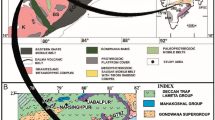Abstract
Our studies show that the granite bodies (γ 2 − 15 and γ 35 ) which constitute the Huangsha-Tieshanlong composite granitic intrusion in Jiangxi are characterized by their similarities in mineral assemblage, petrochemistry, trace element and REE distribution pattern. The values of ΣREE, ΣLREE, ΣHREE, ΣCe/ΣY, δEu and La/Yb apparently decrease from γ 2 − 1a5 to γ 2 − 1b5 , γ 35 and γ 35 . It is shown that the early Yenshanian W(Ta, Nb)-bearing granite (γ 2 − 15 ) and late Yenshanian Ta, Nb-bearing granite (γ 35 ) may have been derived from the differentiation and evolution of granitic magmas due to repeated remelting of the crust and their earlier and later intrusion. Although the earlier (γ 2 − 1b5 and later (γ 35 ) albitized Ta, Nb-bearing granites show some obvious differences in REE content, their δEu values and La/Yb ratios are similar to each other. Therefore, it may be concluded that the early and late Ta, Nb-bearing granites were derived from a congenetic magma.
Similar content being viewed by others
References
Wu Qinsheng et al.,Scientia Sinica (B), 7 (1983), 655–662.
Xia Hongyuan et al., Papers presented at Tungsten Geology Symposium, Jiangxi, China, ESCAP RMRDC (United Nations), 1982, 451–461.
Xu Keqin et al., Proceedings of the International Symposium on Petrogenesis of Granitoids and Their Metallogenetic Relations in South China, Nanjing, China, 1984, Science Press, Beijing, 1–31.
Department of Geology, Nanjing University, «Granitoids of Different Periods in South China and Their Metallogenetic Relations», 1981, Science Press, Beijing, 344–350 (in Chinese).
Xia Hongyuan and Liang Shuyi, «The Crust—the Significance of Granites-Gneisses in the Lithosphere», 1985, Theophrastus Publications S.A. Athens, 571–585.
Xia Hongyuan and Liang Shuyi, Proceedings of the International Symposium on Petrogenesis of Granitoids and Their Metallogenetic Relations in South China, Nanjing, China, 1984, Science Press, Beijing, 651–669.
Wang Zhonggang, Proceedings of the International Symposium on Petrogenesis of Granitoids and Their Metallogenetic Relations in South China, Nanjing, China, 1984, Science Press, Beijing, 787–796.
Kogarko, L.N., Problems of Hydrothermal Ore Deposition,Internat. Union Geol. Sci. A., 2 (1970), 331–333.
Tu Guangchi et al., «Geochemistry», 1984, Shanghai Science and Technology Press, 208–267 (in Chinese).
Iiu Yingyun et al., «Geochemistry of Elements», 1984, Science Press, Beijing, 194–215 (in Chinese).
Author information
Authors and Affiliations
Rights and permissions
About this article
Cite this article
Hongyuan, X., Shuyi, L. Evolution and REE geochemistry of Huangsha-Tieshanlong ore-bearing granite. Chin. J. of Geochem. 7, 207–219 (1988). https://doi.org/10.1007/BF02840963
Issue Date:
DOI: https://doi.org/10.1007/BF02840963




